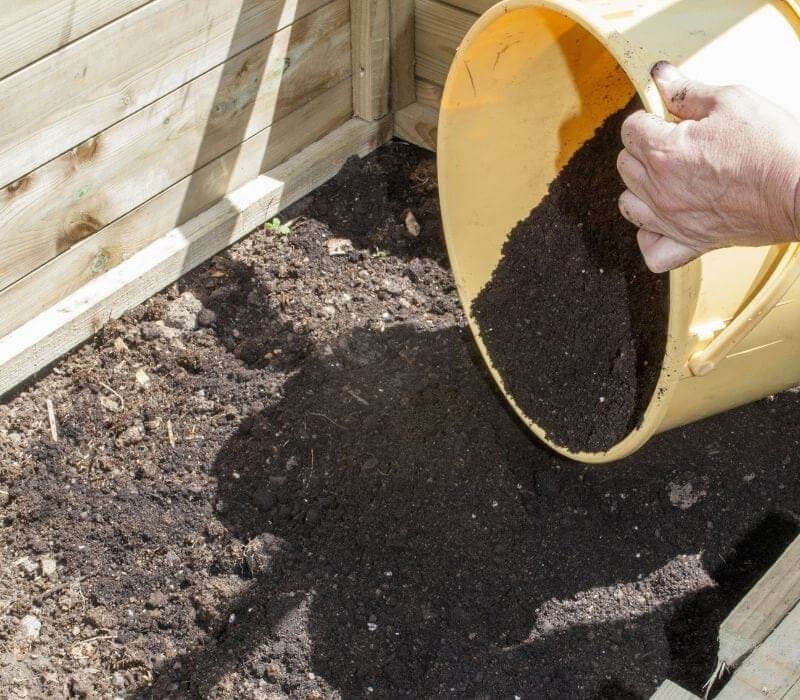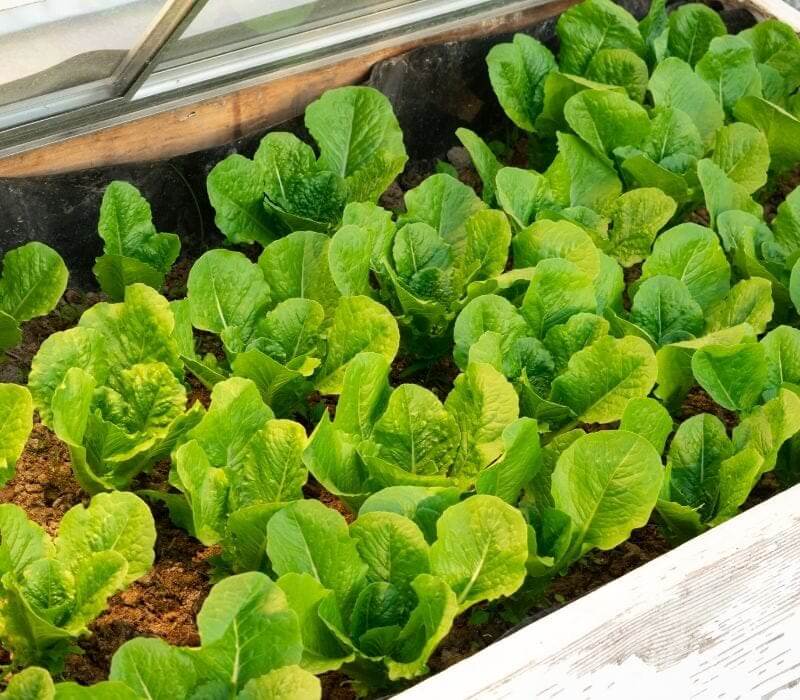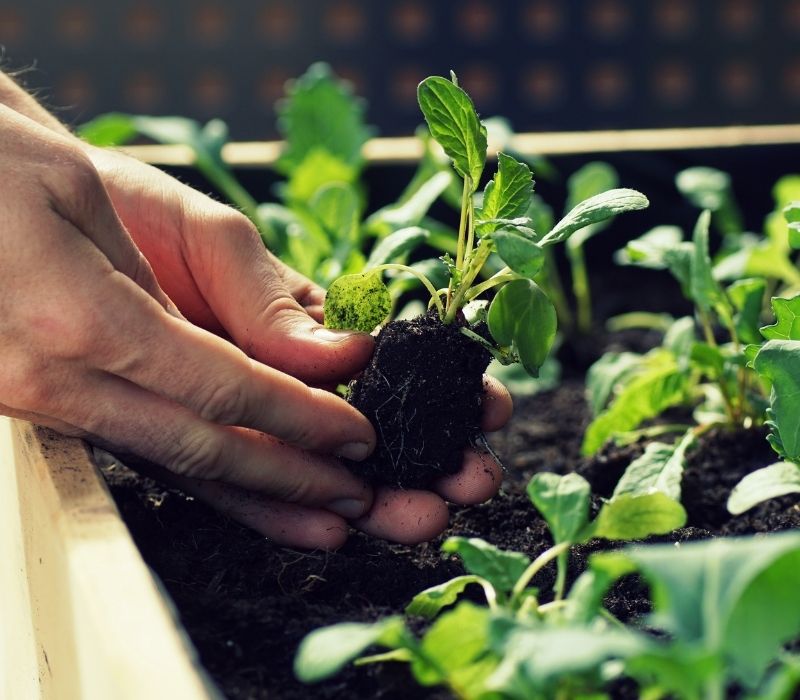Having a cold frame takes the guesswork out when to grow your plants while giving them the best shot at survival, even during inclement weather.
Here is how to make the most out of your cold frame.
RELATED: 17 Cold Weather Plants That Can Survive Winter Outside
How to Use a Cold Frame | Five Ways
1. Protect Dormant Plants During Winter

Do you have theme gardens in your homestead and wonder what to do with the plants during winter? Don’t fret because a cold frame is all you need to overwinter your plants until it is time to bloom them again.
- Firstly, cut back the plants as far as possible before the first frost. If they are not already in containers, sink the roots in large plastic planters – with enough room for soil insulation purposes.
- Secondly, pack the planters tightly in the cold frame and mulch the soil surface. Remember to fill any large air gaps with leaves or mulch. Also, remember to water all the planters at this point.
- Once your plants are well packed in a cold frame, you’ll need to further control the cold frame's conditions to facilitate a healthy dormancy. Therefore, keep the potting soil moist but not wet as the plants don’t need much water over the winter.
- Subsequently, ensure that the plants do not receive much sunlight as this will encourage growth.
Since a cold frame is not a greenhouse, you will not grow lush plants during winter. However, you can effortlessly provide your plants with the right conditions for dormancy, and they will be ready to resume their lush growth in spring.
Tips
- A sunken cold frame offers your plants consistent insulation during winter.
- Overwatering the plants will lead to rotting.
- Use a plastic or foil cover on your cold frame to control the amount of light that penetrates. This also helps in regulating the internal temperature.
- Positioning your cold frame near a windbreak offers your plants much-needed exposure.
2. Extend a Growing or Harvesting Season

You can also use a cold frame to extend the end of a growing or harvesting season. In fall, a blanket of leaves in a cold frame will protect root vegetables like beets and carrots–which are happy to stay in-ground longer from the harsh winter weather for an additional period and ultimately extend your harvest.
Alternatively, it can provide your growing plants with warmer temperatures in early spring. As a result, you can comfortably sow cooler-season veggies up to a month earlier. This way, you get to enjoy a timely harvest of kale, salad greens, and spinach.
Tip: The plants are naturally hardened by the cold temperatures and therefore do not need to stay covered during the day so long as the temperatures are above freezing.
RELATED: How Often To Water Seedlings | 7 Important Tips
3. Start Seedlings Earlier

A few weeks before sowing your early vegetables like peas, spinach, and radishes during spring, it will help to set up a cold frame to mildly warm the soil within the structure to levels required for growing cool-season vegetables.
However, for other plants like tomatoes and peppers that need warmer temperatures during their early stages, only move them to a cold frame temporarily before transplanting them in their last stop if you want to grow them outdoors.
Only place your seedlings in a cold frame a couple of weeks before the expected date of your last frost. And stay alert for any forecast changes.
Tips
- A soil thermometer will help you know when the temperature gets to a consistent seven degrees Celsius for the best results.
- Always keep old blankets at hand to provide your seedling with extra insulation should the need arise.
4. Harden off Seedlings

Like other living things, plants also need to gradually adapt to fluctuations in moisture, temperature, and sunlight when they are moved into the garden from a sheltered location like the indoors.
This can be done by carrying the plants outside and back over an increasing period for a week or two. Similarly, this can be achieved by opening and closing a cold frame over seven days.
For the best result from this process, it is advisable to keep track of the weather forecast to plan accordingly. For instance, you can wait for a time when the lows don’t go below 35 degrees Fahrenheit to harden your cool-season seedlings.
Generally, wait for the seedlings to develop strong roots and form several sets of true leaves to move them into cold frames. And begin venting the structure during the warmest time of the day, starting with a small opening for a short time and gradually progressing until you can leave your frame wide open.
Tip: You will know you are on the right track if the foliage on the seedlings thickens and becomes darker.
5. Convert to Raised Bed
Lastly, as you move through the year and the weather becomes hotter, using a cold frame is no longer necessary. You can detach the lid during this time and use the frame as a raised bed to grow your onions.
It is better than leaving it out to rot or taking up unnecessary space in your storage shed.
Pro Tips
- Since you want your frame to be exposed to as much sunlight as possible, a south-facing location will be the ideal spot. Also, pick a spot with proper drainage to prevent water from pooling.
- Go for a transparent lid. Old windows and doors will do great, but you can also staple plastic sheeting on the frame. For the plastic sheeting, however, a replacement will have to be pinned annually.
- Ensure your cold frame is sealed and insulated always.
- While this is optional, installing an automatic lid opener will save you the trouble of physically monitoring the temperature in the frame and manually opening and closing the lid.
Watch this video from Toronto Star as gardening expert Mark Cullen gives tips on using cold frames:
There you go, homesteaders. With such a high level of versatility, a cold frame is a must-have in every garden. Besides giving your plants a conducive environment, it saves you the cost of building a raised bed during the warmer months.
How do you like using your cold frames? Let us know in the comment section below!
Up Next:
- Raised Garden Beds [Chapter 3] Homestead Handbook
- Beekeeping In Winter: Preparing Beehives For The Cold Season
- How To Fillet A Fish Properly
Fellow homesteaders, do you want to help others learn from your journey by becoming one of our original contributors? Write for us!

I love this project!
Lastly, as you move through the year and the weather becomes hotter, using a cold frame is no longer necessary.